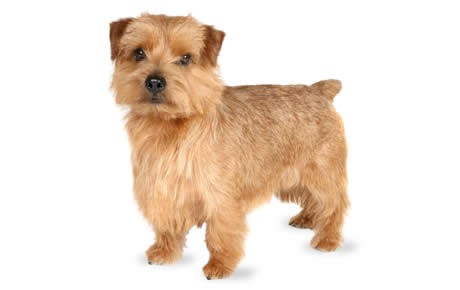Norfolk Terrier Breed Guide

Breed Group:
Terrier Dogs
Get 30% off
Join our Newsletter
Sign Up Today
Norfolk Terrier Background & History
Strong, determined, and loyal- the Norfolk Terrier is a hefty breed that is known for their playful personalities. Originating in England during the 1800’s, the Norfolk Terrier was used for many purposes and was a popular household companion.
During this time, these tiny dogs were known for their excellent hunting skills when it came to vermin and other small rodents. Within the following decades, these canines became a popular pet for Cambridge University students as well, working as both a rat hunter and furry friend. By the 1930s, the Norfolk Terrier was finally recognized as an official breed in both England and the United States.
Norfolk Terrier Personality
Charming and independent, the Norfolk Terrier is a little dog with a lot of personality. At first glance, this pup seems like they would be the perfect lap dog, however, they are capable of so much more. These small and mighty terriers love a good chase and could hunt anything from foxes to vermins.
When they aren’t hunting or taking on a job, these companions love to be with their family. The Norfolk terrier can show total devotion in the right household and will want nothing more than to be surrounded by people they love.
Norfolk Terrier Training
Although not impossible, the Norfolk Terrier can be a difficult breed to train. Just like any terrier, this breed can be stubborn at times and will refuse to do anything they do not wish to do. That’s why it’s important to do consistent training practices that are entertaining and engaging.
If you are still having trouble training your Norfolk Terrier, try enrolling him in a puppy training course. This extra professional assistance will help your dog become a well-mannered pet later on in life and can be the best solution for an inexperienced owner.
Norfolk Terrier Exercise Needs
The Norfolk Terrier should get at least 20-30 minutes of vigorous physical activity on a daily basis. Keep in mind that these terriers absolutely need their exercise and attention to stay happy. If they don’t, they will begin to create their own entertainment by barking and digging.
Norfolk Terrier Lifespan
On average, the Norfolk terrier lives to be about 12 to 15 years old.
Norfolk Terrier Breed Popularity
Norfolk Terriers are quite rare in the United States, which makes it very difficult to adopt one as a pet. As of right now, the American Kennel Club has ranked these dogs as the 134th most popular breed in the United States out of 202 registered breeds.
Norfolk Terrier Feeding Requirements
The Norfolk Terrier should consume between ½ to 1 cup of high-quality food a day, split into two equal meals. Keep in mind each dog is unique and has different feeding requirements. When creating your pet’s feeding regimen, consider his size, age, metabolism, and activity level. Make sure to also feed him nutritious and all-natural food that’s free from preservatives, byproducts, and fillers.
Norfolk Terrier Grooming
The coat of the Norfolk Terrier has two layers and is water resistant, making it easy to maintain with minimal shedding and doesn’t require a strict grooming process. Brush their coat at least once a week to keep it clean and in optimal condition.
It is also important to brush their teeth regularly and clean their ears when needed. Lastly, be sure to trim their nails every couple of weeks to prevent overgrowth and cracking. As a general rule of thumb, if you can hear their nails tapping on the hardwood floor that means it’s time for a trim!
Are Norfolk Terrier Good with Kids?
The Norfolk Terrier is best suited for a family with older children. While their behavior is not an issue, their size makes them vulnerable to accidental injury.
Norfolk Terrier Health Problems
These sturdy dogs are known to be quite healthy, however, just like any breed, they are still prone to several health complications. These health problems may include:
Vaccination sensitivity: Norfolk Terriers have been shown to have great sensitivity to regular vaccinations. When this happens, they may develop hives or an allergic reaction in the area of injection.
Patellar Luxation: Patellar Luxation in dogs occurs when the kneecap becomes dislocated from its normal positioning. This can cause pain and crippling in severe cases.
Hip Dysplasia: Hip dysplasia in dogs is one of the most common health conditions. This hereditary problem occurs when the hip socket and thighbone do not properly fit together, causing the joints to grind against each other and cause pain. In severe cases, arthritis may develop.
Eye problems: Canine cataracts and other eye conditions are known to affect the Norfolk Terrier breed. In order to prevent this, make sure their eyes are getting checked on a regular basis by their veterinarian.
Other Resources
National Breed Website: Norfolk Terrier Club
Rescue: Norfolk Terrier Club Rescue
